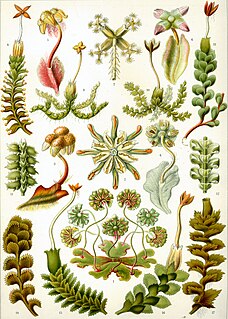
The Marchantiophyta are a division of non-vascular land plants commonly referred to as hepatics or liverworts. Like mosses and hornworts, they have a gametophyte-dominant life cycle, in which cells of the plant carry only a single set of genetic information.

The phascogales, also known as wambengers or mousesacks, are carnivorous Australian marsupials of the family Dasyuridae. There are three species: the brush-tailed phascogale, the red-tailed phascogale, and the northern brush-tailed phascogale. As with a number of dasyurid species, the males live for only one year, dying after a period of frenzied mating. The term Phascogale was coined in 1824 by Coenraad Jacob Temminck in reference to the brush-tailed phascogale, and means "pouched weasel". All three species are listed as either Near Threatened or Vulnerable by the IUCN.

The white-winged vampire bat, a species of vampire bat, is the only member of the genus Diaemus. They are found from Mexico to northern Argentina and are present on the islands of Trinidad and Margarita.
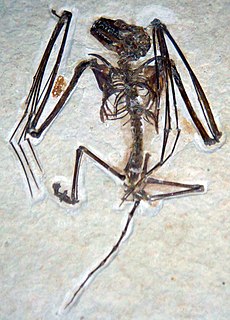
Icaronycteris is an extinct genus of microchiropteran (echolocating) bat that lived in the early Eocene, approximately 52.2 million years ago, making it the earliest known definitive bat. Four exceptionally preserved specimens, among the best preserved bat fossils, are known from the Green River Formation of North America. There is only one thoroughly described species of bat in the genus, I. index, although fragmentary material from France has also been tentatively placed within Icaronycteris as the second species I. menui. I. sigei is based on well-preserved fragments of dentaries and lower teeth found in Western India.

Sody's tree rat is a rodent species in the family Muridae that has been recorded only in bamboo forest in Gunung Gede Pangrango National Park, West Java, Indonesia. It was first recorded during surveys carried out between 1933 and 1935 at an altitude of 1,000 m (3,300 ft). It is dark brown and has yellow to ochre spots. Its tail is uniform brown. Its head-to-body length ranges from 18 to 21 cm with a 27 to 30.5 cm long tail. Its long feet indicate that it is adapted to living in trees.

Ichthyophis hypocyaneus, the bantam caecilian, is a species of amphibian in the family Ichthyophiidae of caecilians, endemic to Indonesia. Until its rediscovery in 2000, it was known only from the 1827 type specimen.
Phycolepidozia exigua is the only species of liverwort in the genus Phycolepidozia and family Phycolepidoziaceae. It is endemic to Dominica, where it is critically endangered. Its natural habitat is subtropical or tropical moist lowland forests.

Haplomitriopsida is a newly recognized class of liverworts comprising fifteen species in three genera. Recent cladistic analyses of nuclear, mitochondrial, and plastid gene sequences place this monophyletic group as the basal sister group to all other liverworts. The group thus provides a unique insight into the early evolution of liverworts in particular and of land plants in general.
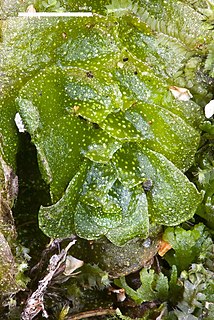
Treubia is a genus of liverworts in the family Treubiaceae. There are seven species, all of which are restricted to the southern hemisphere. Five of the species occur in Australasia and the other occurs in Chile. All species are dioicous, with separate male and female gametophytes.
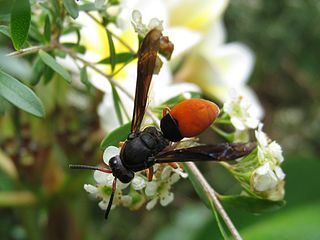
Pseudabispa is an Australian and Papuan genus of potter wasps containing 5 species, one of them subdivided in 4 subspecies.
Kennetia is a small Indomalayan genus of potter wasps. It should be spelled Kennethia but Antonio Giordani Soika misspelled the name in his original description of the genus.
Latimenes is a monotypic Indomalayan genus of potter wasps, the single species, Latimenes latipennis, was originally named by Frederick Smith in 1858 as Odynerus latipennis.
Hirtocoelius is a monotypic Australasian genus of potter wasps. The sole species is Hirtocoelius aureoniger.

Eusynthemis is a genus of dragonflies in the family Synthemistidae. They are commonly known as tigertails. Species of this genus are found mostly in Australia with one species, Eusynthemis frontalis, found in the Solomon Islands.
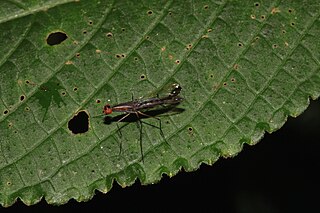
The family Nothybidae contains only the genus Nothybus, a group of colorful and elongated flies. The family has been recently revised.

Trigonopterus amphoralis is a species of flightless weevil in the genus Trigonopterus from Indonesia.
Maxomys tajuddinii is a species of rodent in the genus Maxomys. It is found in Indonesia and Malaysia. It is a rodent of medium size, with a tail length of 106.9-122.3 mm, feet of 27.62-30.04 mm and a weight of up to 70 g.
Orthelimaea is a genus of Asian bush crickets in the tribe Elimaeini within the subfamily Phaneropterinae. Species in this genus are found in India, Indo-China, and Malesia.
Lonchophylla orienticollina is a species of bat found in Colombia, Venezuela, and Ecuador.

Kurixalus absconditus is a species of frog in the family Rhacophoridae. It is endemic to West Kalimantan, in the Indonesian part of Borneo, and is only known from its type locality near the village of Piasak; it is likely to occur more widely. The specific name absconditus is Latin for "disguised", "concealed", or "hidden", and refers to this species remaining "undetected" within the Kurixalus appendiculatus group. Common name Piasak-frilled swamp treefrog, also spelled Piasak frilled swamp tree frog, has been coined for it.











